
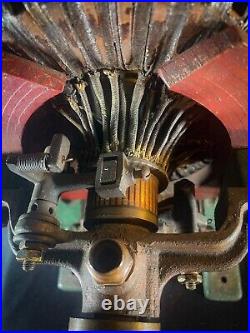

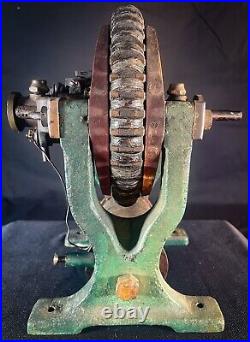
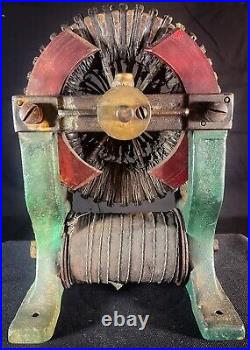




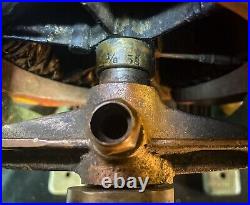
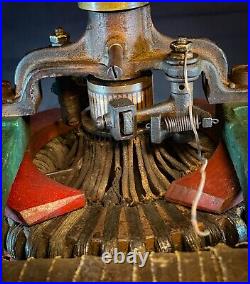
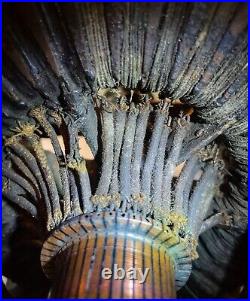
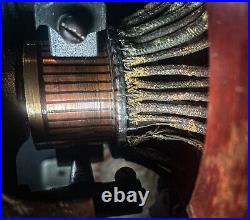
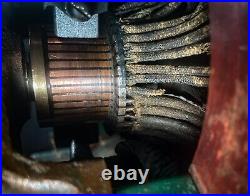


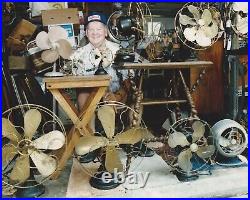

Loyd Davis, was an avid antique electric fan collector until his passing in 2011. The plan is to list 5-7 fans every week for sale. BUYERS within the continental U. BUYERS FROM OUTSIDE THE CONTINENTAL U. I hope that everyone can get a fan that they will enjoy as much as my dad did! A VERY RARE and EARLY Edison 1891 Small Slow Motor that operates with 1/6 HP at 125V DC. This early 1891 DC bipolar motor was designed by Thomas Edison to meet a growing need for small motors to replace hand and/or steam power in a variety of everyday applications. This 1/6 HP motor was used for both electric fans and as a general purpose utility motor. This VERY UNIQUE motor design features a fully-exposed Pacinotti ring armature suspended between four C-shaped magnets held in two Y-shaped cast iron yoke supports. The Pacinotti ring armature used in this motor by Edison was honored with an IEEE Milestone in December 2018 recognizing its importance in paving the way for practical and reliable electrical machines. ” The motor is about 9.5″ tall measured to the top of the armature and 6.75 tall measured to the top of the Y-shaped supports. The motor weighs 20 lbs. The brass collar on the front side of the shaft is stamped? (see photo) which indicates that this is a? Horsepower (HP) small slow-speed motor. An Edison General Electric Co. Catalog from the early 1890’s has the? HP slow-speed motor listed as Cat. According to the specification in the catalog, this motor requires 125 V DC power and operates at a “slow” 1900 rpm. This seems fast for a small motor of this era, but I guess? This is slower than larger Edison DC motors that preceded this 1891 small slow motor design. Technical publications of the era e. The Electrical Engineer routinely noted the small compact size, light weight, and slow speed of these motors as key features. A bar-to-bar continuity test on the commutator indicates that 8 out of 41 connections to the armature windings are an open circuit. Consequently, this motor does NOT run. We believe that with precision and care these connections could be fixed to preserve the original armature windings and make this motor operational. A working Edison slow motor ca. So with a little “sweat equity” the next owner has an opportunity to increase the value of this important and rare Edison motor considerably. See video & photos. This listing is for 1 item only. The last photo is meant to honor my dad as it shows him enjoying a handful of his antique fans. I describe each fan to the best of my ability. It is possible that parts cages, blades, etc. May not be those that were originally on the fan when it was manufactured. However, I have researched most of these fans using the AFCA website and other well respected websites and will disclose any information I have learned in my research about each fan. The fans that I’m listing are ANTIQUES that range in age from 70-130 years old. It’s reasonable to assume that cords, plugs, etc. Might not be perfect on every fan that I list, and that some might even need to be replaced. Use the zoom option to examine my detailed photos and make your own determination regarding condition. When I identify a fan size 8″, 9″, 10″, 12″, etc. In my listings, this is based on the measurement across the blades, from tip of the blade to tip of the blade. I test the blades & cage of each fan that I list with a magnet. If the magnet DOESN’T STICK to the blades or cage, then I believe these are brass. If the magnet DOES STICK to the blades or cage, then I assume these are steel. If you have any specific questions about this fan that I haven’t covered in this listing or are not clear in the photos, please feel free to ask, and I will do my best to answer them.

Incoming search terms:
- edison electric fan for sale


